BSBWHS401: Implementing and Monitoring WHS Policies - Sydney Uni
VerifiedAdded on 2023/06/11
|37
|7727
|136
Report
AI Summary
This BSBWHS401 assignment solution provides a detailed review of the Work Health and Safety (WHS) management system at the University of Sydney, examining its compliance with the Work Health and Safety Act 2011. It covers hazard identification, risk management, and the university's policies and procedures for maintaining a safe environment for students, staff, and affiliates. The assignment highlights how the university addresses legal and regulatory obligations through its WHS policy, focusing on aspects such as governance structure, monitoring processes, and specific risk management strategies for hazards like chemicals, confined spaces, electricity, and ergonomic issues. The document emphasizes the university's commitment to continuous improvement and adherence to safety standards, offering a comprehensive overview of WHS implementation at the University of Sydney. Desklib offers a platform to access this document along with other solved assignments and study resources.
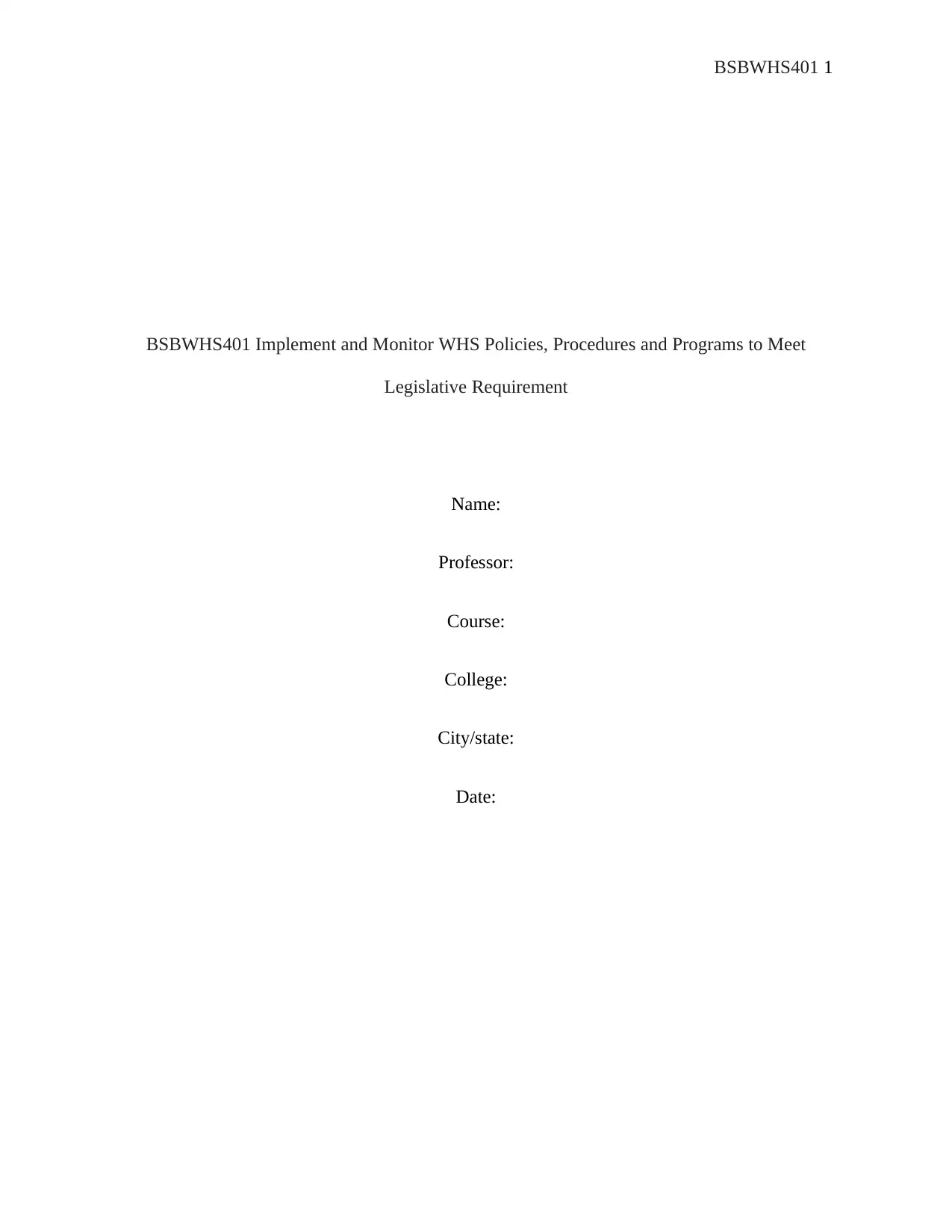
BSBWHS401 1
BSBWHS401 Implement and Monitor WHS Policies, Procedures and Programs to Meet
Legislative Requirement
Name:
Professor:
Course:
College:
City/state:
Date:
BSBWHS401 Implement and Monitor WHS Policies, Procedures and Programs to Meet
Legislative Requirement
Name:
Professor:
Course:
College:
City/state:
Date:
Paraphrase This Document
Need a fresh take? Get an instant paraphrase of this document with our AI Paraphraser
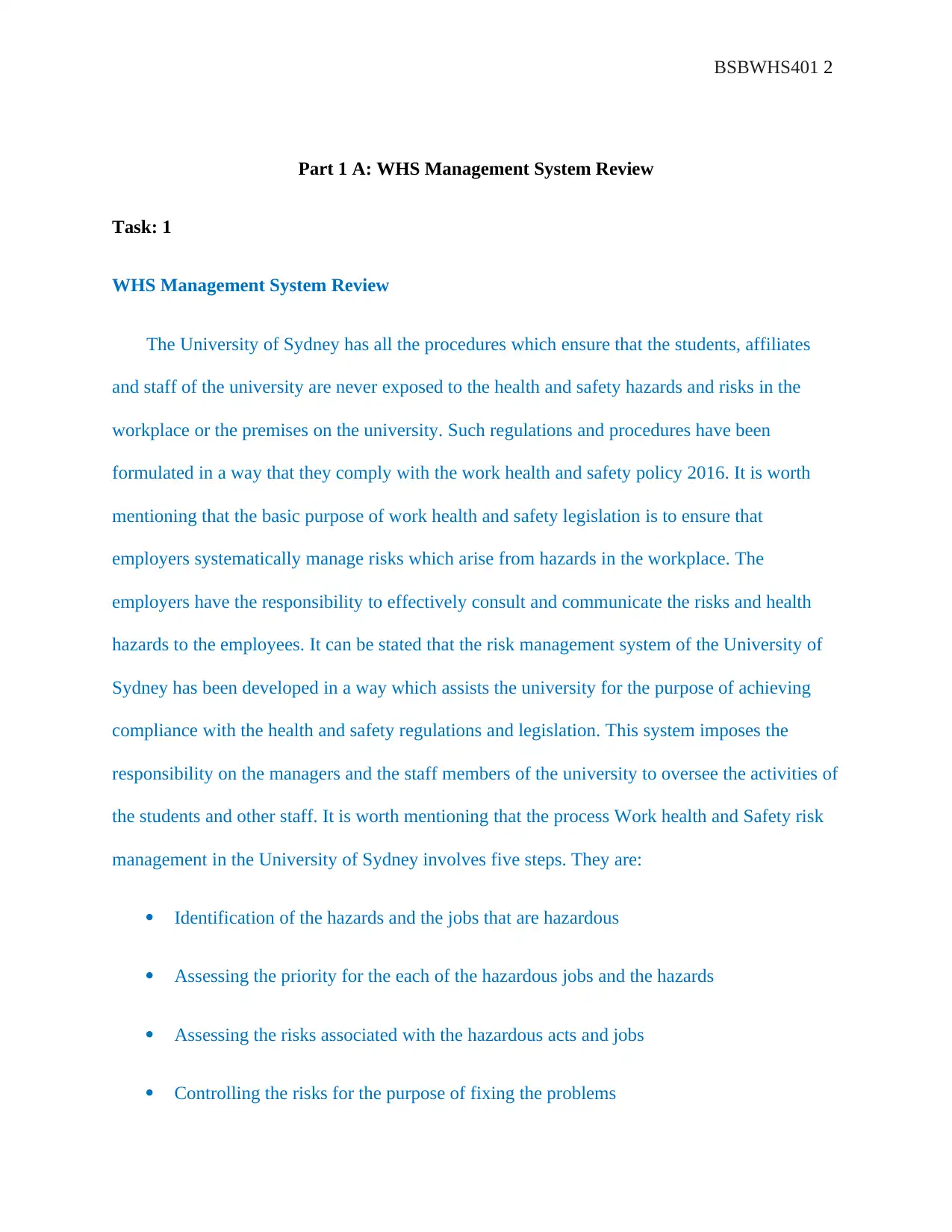
BSBWHS401 2
Part 1 A: WHS Management System Review
Task: 1
WHS Management System Review
The University of Sydney has all the procedures which ensure that the students, affiliates
and staff of the university are never exposed to the health and safety hazards and risks in the
workplace or the premises on the university. Such regulations and procedures have been
formulated in a way that they comply with the work health and safety policy 2016. It is worth
mentioning that the basic purpose of work health and safety legislation is to ensure that
employers systematically manage risks which arise from hazards in the workplace. The
employers have the responsibility to effectively consult and communicate the risks and health
hazards to the employees. It can be stated that the risk management system of the University of
Sydney has been developed in a way which assists the university for the purpose of achieving
compliance with the health and safety regulations and legislation. This system imposes the
responsibility on the managers and the staff members of the university to oversee the activities of
the students and other staff. It is worth mentioning that the process Work health and Safety risk
management in the University of Sydney involves five steps. They are:
Identification of the hazards and the jobs that are hazardous
Assessing the priority for the each of the hazardous jobs and the hazards
Assessing the risks associated with the hazardous acts and jobs
Controlling the risks for the purpose of fixing the problems
Part 1 A: WHS Management System Review
Task: 1
WHS Management System Review
The University of Sydney has all the procedures which ensure that the students, affiliates
and staff of the university are never exposed to the health and safety hazards and risks in the
workplace or the premises on the university. Such regulations and procedures have been
formulated in a way that they comply with the work health and safety policy 2016. It is worth
mentioning that the basic purpose of work health and safety legislation is to ensure that
employers systematically manage risks which arise from hazards in the workplace. The
employers have the responsibility to effectively consult and communicate the risks and health
hazards to the employees. It can be stated that the risk management system of the University of
Sydney has been developed in a way which assists the university for the purpose of achieving
compliance with the health and safety regulations and legislation. This system imposes the
responsibility on the managers and the staff members of the university to oversee the activities of
the students and other staff. It is worth mentioning that the process Work health and Safety risk
management in the University of Sydney involves five steps. They are:
Identification of the hazards and the jobs that are hazardous
Assessing the priority for the each of the hazardous jobs and the hazards
Assessing the risks associated with the hazardous acts and jobs
Controlling the risks for the purpose of fixing the problems
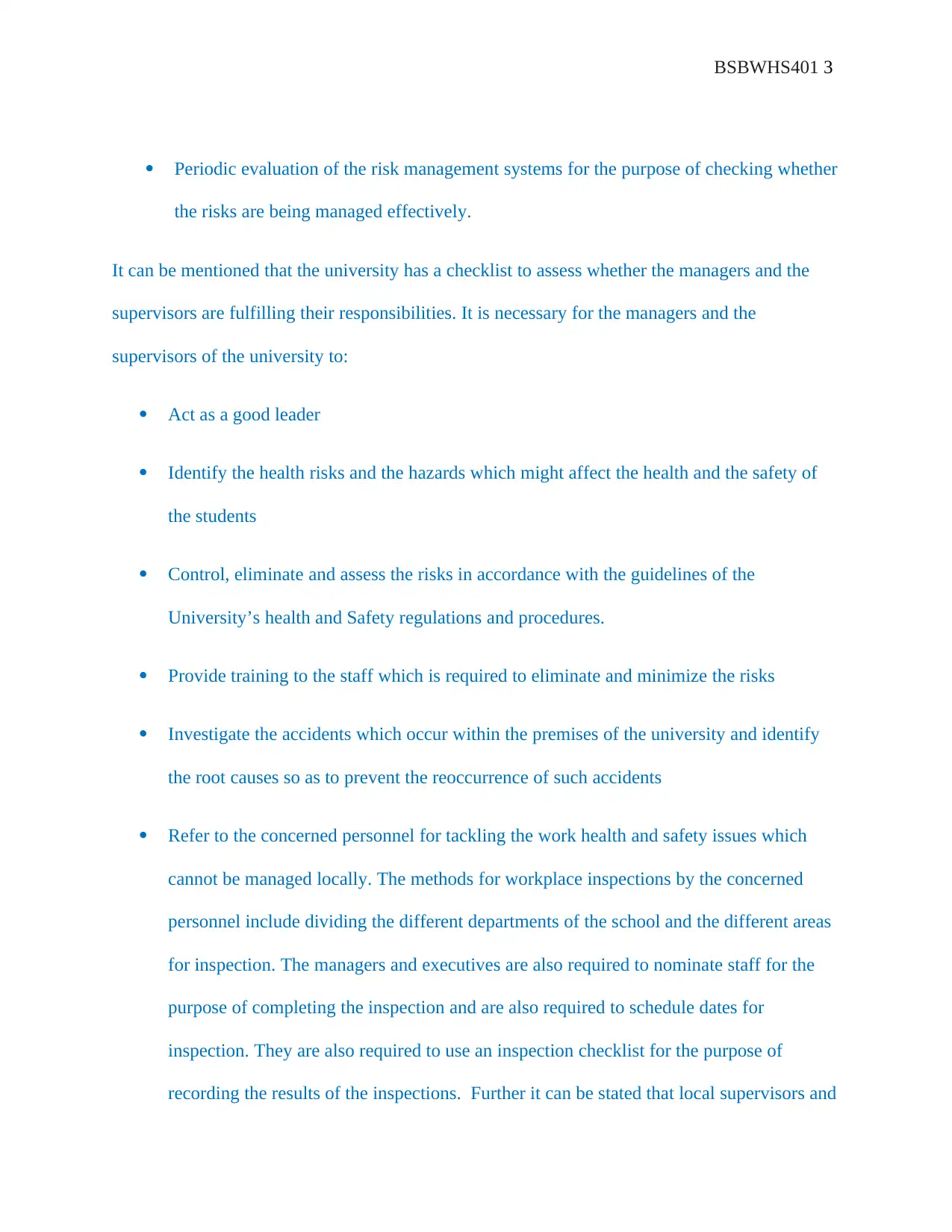
BSBWHS401 3
Periodic evaluation of the risk management systems for the purpose of checking whether
the risks are being managed effectively.
It can be mentioned that the university has a checklist to assess whether the managers and the
supervisors are fulfilling their responsibilities. It is necessary for the managers and the
supervisors of the university to:
Act as a good leader
Identify the health risks and the hazards which might affect the health and the safety of
the students
Control, eliminate and assess the risks in accordance with the guidelines of the
University’s health and Safety regulations and procedures.
Provide training to the staff which is required to eliminate and minimize the risks
Investigate the accidents which occur within the premises of the university and identify
the root causes so as to prevent the reoccurrence of such accidents
Refer to the concerned personnel for tackling the work health and safety issues which
cannot be managed locally. The methods for workplace inspections by the concerned
personnel include dividing the different departments of the school and the different areas
for inspection. The managers and executives are also required to nominate staff for the
purpose of completing the inspection and are also required to schedule dates for
inspection. They are also required to use an inspection checklist for the purpose of
recording the results of the inspections. Further it can be stated that local supervisors and
Periodic evaluation of the risk management systems for the purpose of checking whether
the risks are being managed effectively.
It can be mentioned that the university has a checklist to assess whether the managers and the
supervisors are fulfilling their responsibilities. It is necessary for the managers and the
supervisors of the university to:
Act as a good leader
Identify the health risks and the hazards which might affect the health and the safety of
the students
Control, eliminate and assess the risks in accordance with the guidelines of the
University’s health and Safety regulations and procedures.
Provide training to the staff which is required to eliminate and minimize the risks
Investigate the accidents which occur within the premises of the university and identify
the root causes so as to prevent the reoccurrence of such accidents
Refer to the concerned personnel for tackling the work health and safety issues which
cannot be managed locally. The methods for workplace inspections by the concerned
personnel include dividing the different departments of the school and the different areas
for inspection. The managers and executives are also required to nominate staff for the
purpose of completing the inspection and are also required to schedule dates for
inspection. They are also required to use an inspection checklist for the purpose of
recording the results of the inspections. Further it can be stated that local supervisors and
⊘ This is a preview!⊘
Do you want full access?
Subscribe today to unlock all pages.

Trusted by 1+ million students worldwide
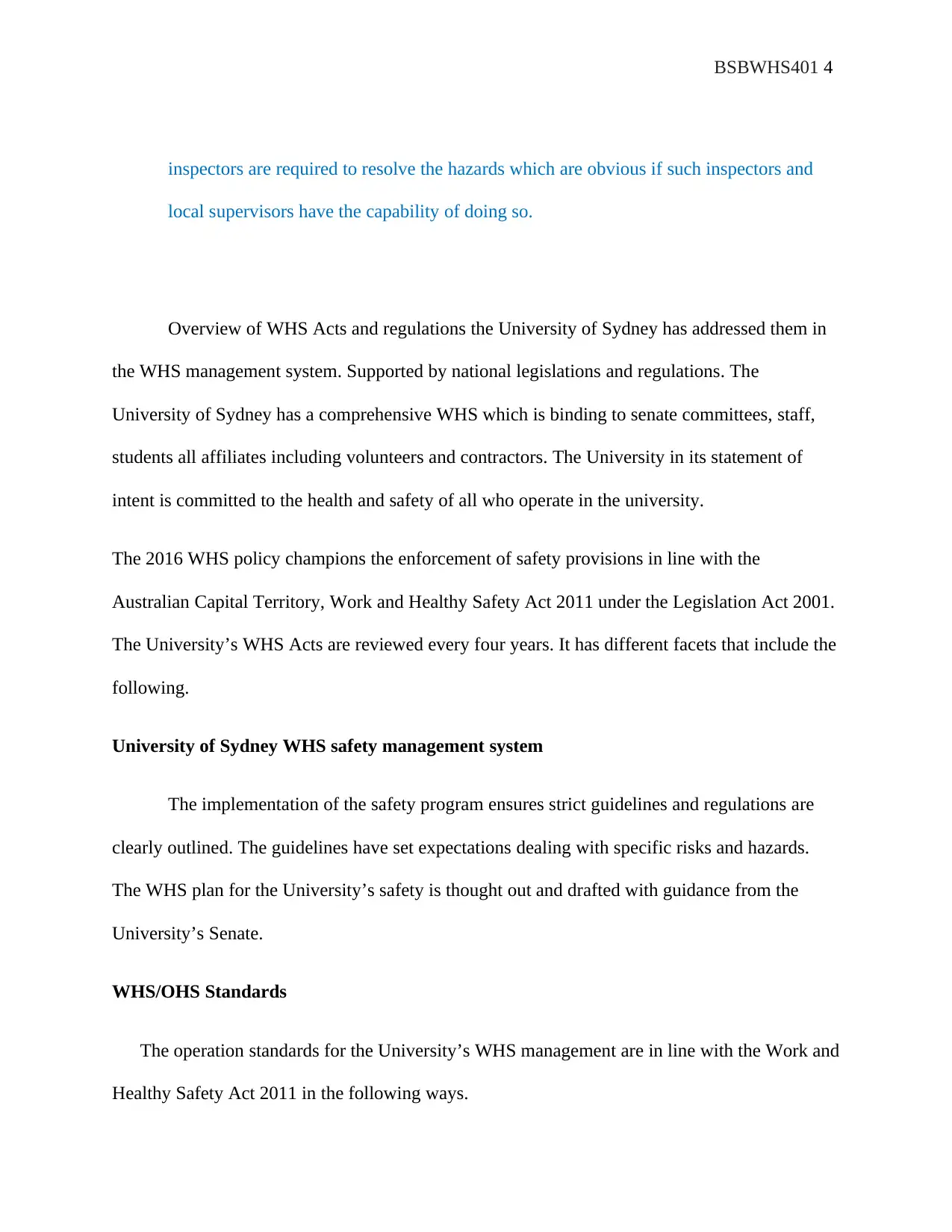
BSBWHS401 4
inspectors are required to resolve the hazards which are obvious if such inspectors and
local supervisors have the capability of doing so.
Overview of WHS Acts and regulations the University of Sydney has addressed them in
the WHS management system. Supported by national legislations and regulations. The
University of Sydney has a comprehensive WHS which is binding to senate committees, staff,
students all affiliates including volunteers and contractors. The University in its statement of
intent is committed to the health and safety of all who operate in the university.
The 2016 WHS policy champions the enforcement of safety provisions in line with the
Australian Capital Territory, Work and Healthy Safety Act 2011 under the Legislation Act 2001.
The University’s WHS Acts are reviewed every four years. It has different facets that include the
following.
University of Sydney WHS safety management system
The implementation of the safety program ensures strict guidelines and regulations are
clearly outlined. The guidelines have set expectations dealing with specific risks and hazards.
The WHS plan for the University’s safety is thought out and drafted with guidance from the
University’s Senate.
WHS/OHS Standards
The operation standards for the University’s WHS management are in line with the Work and
Healthy Safety Act 2011 in the following ways.
inspectors are required to resolve the hazards which are obvious if such inspectors and
local supervisors have the capability of doing so.
Overview of WHS Acts and regulations the University of Sydney has addressed them in
the WHS management system. Supported by national legislations and regulations. The
University of Sydney has a comprehensive WHS which is binding to senate committees, staff,
students all affiliates including volunteers and contractors. The University in its statement of
intent is committed to the health and safety of all who operate in the university.
The 2016 WHS policy champions the enforcement of safety provisions in line with the
Australian Capital Territory, Work and Healthy Safety Act 2011 under the Legislation Act 2001.
The University’s WHS Acts are reviewed every four years. It has different facets that include the
following.
University of Sydney WHS safety management system
The implementation of the safety program ensures strict guidelines and regulations are
clearly outlined. The guidelines have set expectations dealing with specific risks and hazards.
The WHS plan for the University’s safety is thought out and drafted with guidance from the
University’s Senate.
WHS/OHS Standards
The operation standards for the University’s WHS management are in line with the Work and
Healthy Safety Act 2011 in the following ways.
Paraphrase This Document
Need a fresh take? Get an instant paraphrase of this document with our AI Paraphraser
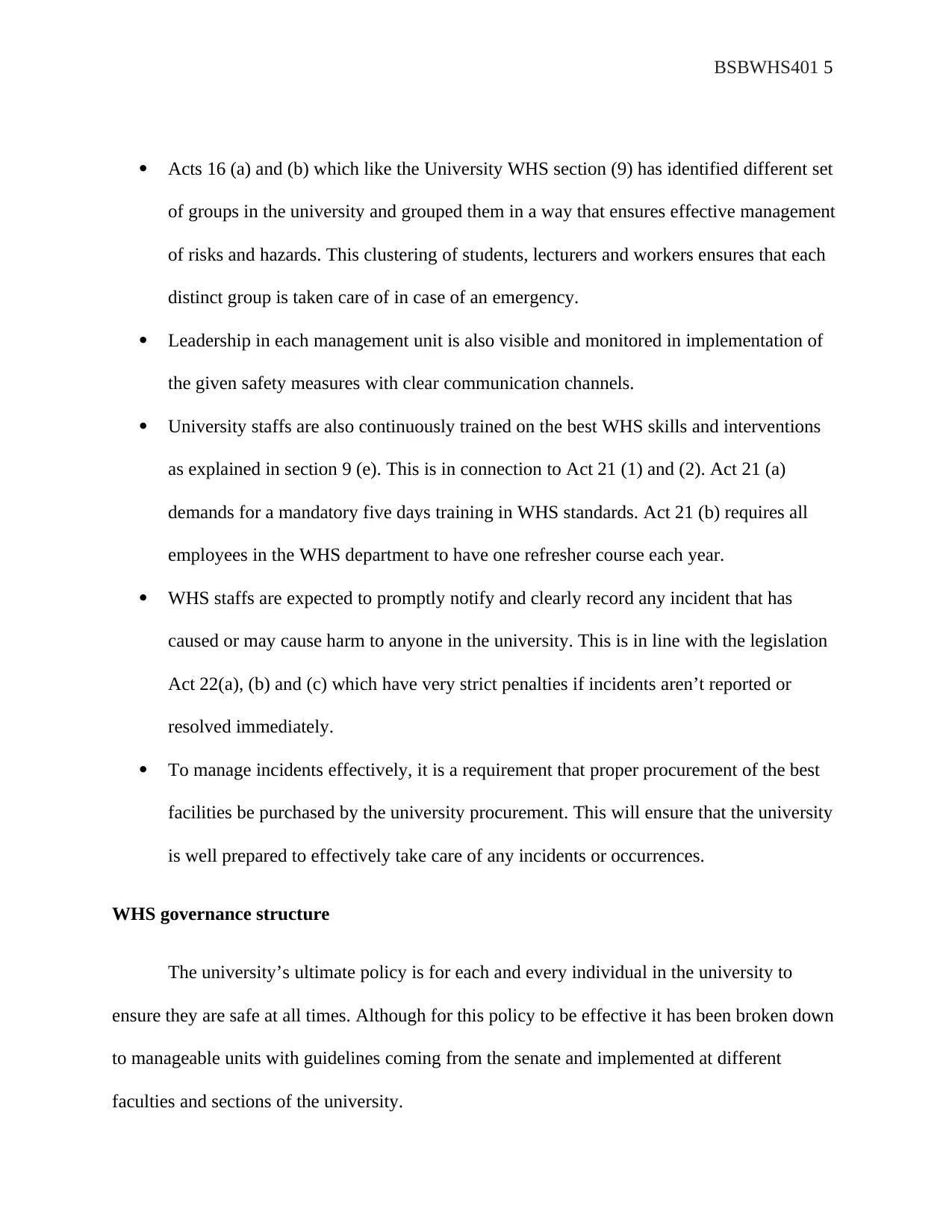
BSBWHS401 5
Acts 16 (a) and (b) which like the University WHS section (9) has identified different set
of groups in the university and grouped them in a way that ensures effective management
of risks and hazards. This clustering of students, lecturers and workers ensures that each
distinct group is taken care of in case of an emergency.
Leadership in each management unit is also visible and monitored in implementation of
the given safety measures with clear communication channels.
University staffs are also continuously trained on the best WHS skills and interventions
as explained in section 9 (e). This is in connection to Act 21 (1) and (2). Act 21 (a)
demands for a mandatory five days training in WHS standards. Act 21 (b) requires all
employees in the WHS department to have one refresher course each year.
WHS staffs are expected to promptly notify and clearly record any incident that has
caused or may cause harm to anyone in the university. This is in line with the legislation
Act 22(a), (b) and (c) which have very strict penalties if incidents aren’t reported or
resolved immediately.
To manage incidents effectively, it is a requirement that proper procurement of the best
facilities be purchased by the university procurement. This will ensure that the university
is well prepared to effectively take care of any incidents or occurrences.
WHS governance structure
The university’s ultimate policy is for each and every individual in the university to
ensure they are safe at all times. Although for this policy to be effective it has been broken down
to manageable units with guidelines coming from the senate and implemented at different
faculties and sections of the university.
Acts 16 (a) and (b) which like the University WHS section (9) has identified different set
of groups in the university and grouped them in a way that ensures effective management
of risks and hazards. This clustering of students, lecturers and workers ensures that each
distinct group is taken care of in case of an emergency.
Leadership in each management unit is also visible and monitored in implementation of
the given safety measures with clear communication channels.
University staffs are also continuously trained on the best WHS skills and interventions
as explained in section 9 (e). This is in connection to Act 21 (1) and (2). Act 21 (a)
demands for a mandatory five days training in WHS standards. Act 21 (b) requires all
employees in the WHS department to have one refresher course each year.
WHS staffs are expected to promptly notify and clearly record any incident that has
caused or may cause harm to anyone in the university. This is in line with the legislation
Act 22(a), (b) and (c) which have very strict penalties if incidents aren’t reported or
resolved immediately.
To manage incidents effectively, it is a requirement that proper procurement of the best
facilities be purchased by the university procurement. This will ensure that the university
is well prepared to effectively take care of any incidents or occurrences.
WHS governance structure
The university’s ultimate policy is for each and every individual in the university to
ensure they are safe at all times. Although for this policy to be effective it has been broken down
to manageable units with guidelines coming from the senate and implemented at different
faculties and sections of the university.
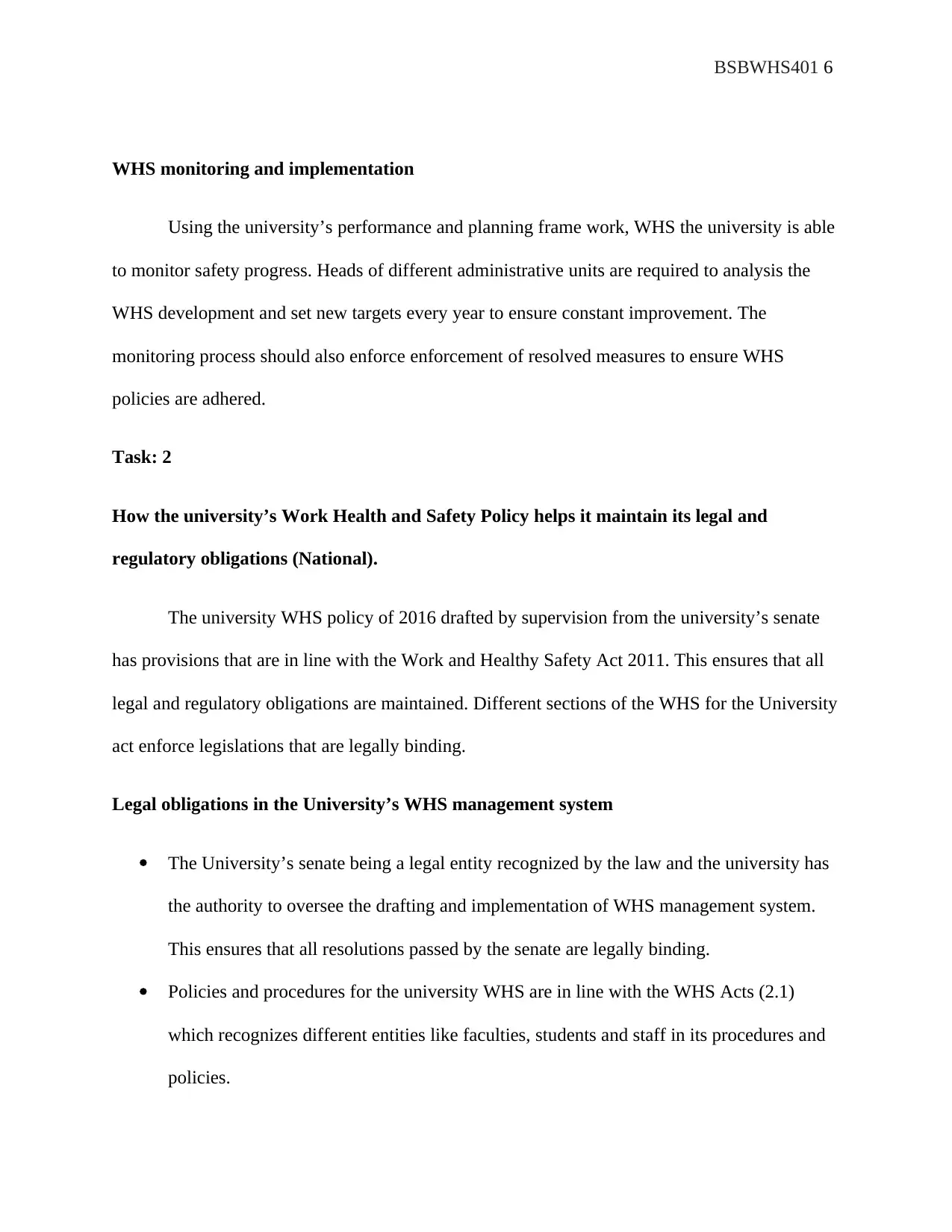
BSBWHS401 6
WHS monitoring and implementation
Using the university’s performance and planning frame work, WHS the university is able
to monitor safety progress. Heads of different administrative units are required to analysis the
WHS development and set new targets every year to ensure constant improvement. The
monitoring process should also enforce enforcement of resolved measures to ensure WHS
policies are adhered.
Task: 2
How the university’s Work Health and Safety Policy helps it maintain its legal and
regulatory obligations (National).
The university WHS policy of 2016 drafted by supervision from the university’s senate
has provisions that are in line with the Work and Healthy Safety Act 2011. This ensures that all
legal and regulatory obligations are maintained. Different sections of the WHS for the University
act enforce legislations that are legally binding.
Legal obligations in the University’s WHS management system
The University’s senate being a legal entity recognized by the law and the university has
the authority to oversee the drafting and implementation of WHS management system.
This ensures that all resolutions passed by the senate are legally binding.
Policies and procedures for the university WHS are in line with the WHS Acts (2.1)
which recognizes different entities like faculties, students and staff in its procedures and
policies.
WHS monitoring and implementation
Using the university’s performance and planning frame work, WHS the university is able
to monitor safety progress. Heads of different administrative units are required to analysis the
WHS development and set new targets every year to ensure constant improvement. The
monitoring process should also enforce enforcement of resolved measures to ensure WHS
policies are adhered.
Task: 2
How the university’s Work Health and Safety Policy helps it maintain its legal and
regulatory obligations (National).
The university WHS policy of 2016 drafted by supervision from the university’s senate
has provisions that are in line with the Work and Healthy Safety Act 2011. This ensures that all
legal and regulatory obligations are maintained. Different sections of the WHS for the University
act enforce legislations that are legally binding.
Legal obligations in the University’s WHS management system
The University’s senate being a legal entity recognized by the law and the university has
the authority to oversee the drafting and implementation of WHS management system.
This ensures that all resolutions passed by the senate are legally binding.
Policies and procedures for the university WHS are in line with the WHS Acts (2.1)
which recognizes different entities like faculties, students and staff in its procedures and
policies.
⊘ This is a preview!⊘
Do you want full access?
Subscribe today to unlock all pages.

Trusted by 1+ million students worldwide
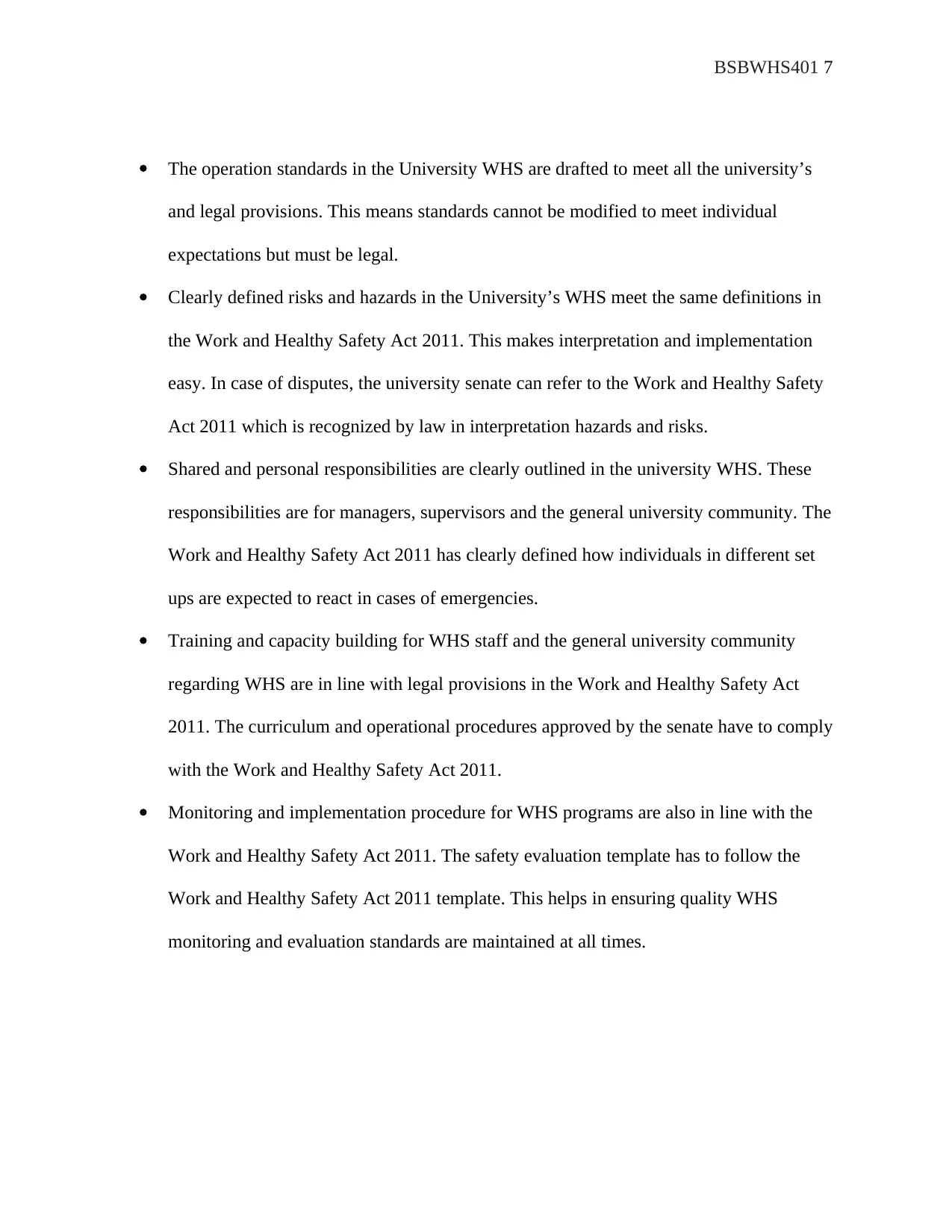
BSBWHS401 7
The operation standards in the University WHS are drafted to meet all the university’s
and legal provisions. This means standards cannot be modified to meet individual
expectations but must be legal.
Clearly defined risks and hazards in the University’s WHS meet the same definitions in
the Work and Healthy Safety Act 2011. This makes interpretation and implementation
easy. In case of disputes, the university senate can refer to the Work and Healthy Safety
Act 2011 which is recognized by law in interpretation hazards and risks.
Shared and personal responsibilities are clearly outlined in the university WHS. These
responsibilities are for managers, supervisors and the general university community. The
Work and Healthy Safety Act 2011 has clearly defined how individuals in different set
ups are expected to react in cases of emergencies.
Training and capacity building for WHS staff and the general university community
regarding WHS are in line with legal provisions in the Work and Healthy Safety Act
2011. The curriculum and operational procedures approved by the senate have to comply
with the Work and Healthy Safety Act 2011.
Monitoring and implementation procedure for WHS programs are also in line with the
Work and Healthy Safety Act 2011. The safety evaluation template has to follow the
Work and Healthy Safety Act 2011 template. This helps in ensuring quality WHS
monitoring and evaluation standards are maintained at all times.
The operation standards in the University WHS are drafted to meet all the university’s
and legal provisions. This means standards cannot be modified to meet individual
expectations but must be legal.
Clearly defined risks and hazards in the University’s WHS meet the same definitions in
the Work and Healthy Safety Act 2011. This makes interpretation and implementation
easy. In case of disputes, the university senate can refer to the Work and Healthy Safety
Act 2011 which is recognized by law in interpretation hazards and risks.
Shared and personal responsibilities are clearly outlined in the university WHS. These
responsibilities are for managers, supervisors and the general university community. The
Work and Healthy Safety Act 2011 has clearly defined how individuals in different set
ups are expected to react in cases of emergencies.
Training and capacity building for WHS staff and the general university community
regarding WHS are in line with legal provisions in the Work and Healthy Safety Act
2011. The curriculum and operational procedures approved by the senate have to comply
with the Work and Healthy Safety Act 2011.
Monitoring and implementation procedure for WHS programs are also in line with the
Work and Healthy Safety Act 2011. The safety evaluation template has to follow the
Work and Healthy Safety Act 2011 template. This helps in ensuring quality WHS
monitoring and evaluation standards are maintained at all times.
Paraphrase This Document
Need a fresh take? Get an instant paraphrase of this document with our AI Paraphraser
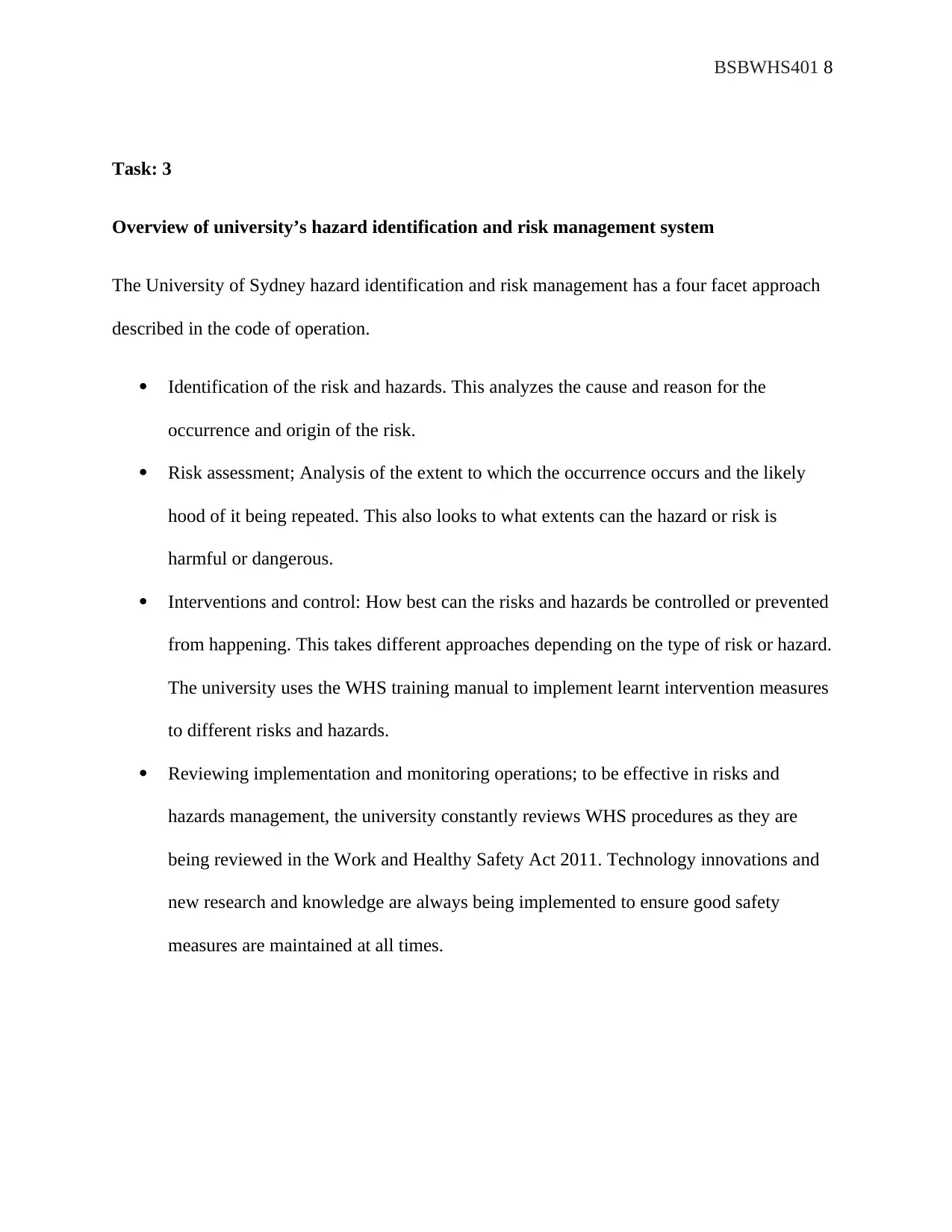
BSBWHS401 8
Task: 3
Overview of university’s hazard identification and risk management system
The University of Sydney hazard identification and risk management has a four facet approach
described in the code of operation.
Identification of the risk and hazards. This analyzes the cause and reason for the
occurrence and origin of the risk.
Risk assessment; Analysis of the extent to which the occurrence occurs and the likely
hood of it being repeated. This also looks to what extents can the hazard or risk is
harmful or dangerous.
Interventions and control: How best can the risks and hazards be controlled or prevented
from happening. This takes different approaches depending on the type of risk or hazard.
The university uses the WHS training manual to implement learnt intervention measures
to different risks and hazards.
Reviewing implementation and monitoring operations; to be effective in risks and
hazards management, the university constantly reviews WHS procedures as they are
being reviewed in the Work and Healthy Safety Act 2011. Technology innovations and
new research and knowledge are always being implemented to ensure good safety
measures are maintained at all times.
Task: 3
Overview of university’s hazard identification and risk management system
The University of Sydney hazard identification and risk management has a four facet approach
described in the code of operation.
Identification of the risk and hazards. This analyzes the cause and reason for the
occurrence and origin of the risk.
Risk assessment; Analysis of the extent to which the occurrence occurs and the likely
hood of it being repeated. This also looks to what extents can the hazard or risk is
harmful or dangerous.
Interventions and control: How best can the risks and hazards be controlled or prevented
from happening. This takes different approaches depending on the type of risk or hazard.
The university uses the WHS training manual to implement learnt intervention measures
to different risks and hazards.
Reviewing implementation and monitoring operations; to be effective in risks and
hazards management, the university constantly reviews WHS procedures as they are
being reviewed in the Work and Healthy Safety Act 2011. Technology innovations and
new research and knowledge are always being implemented to ensure good safety
measures are maintained at all times.
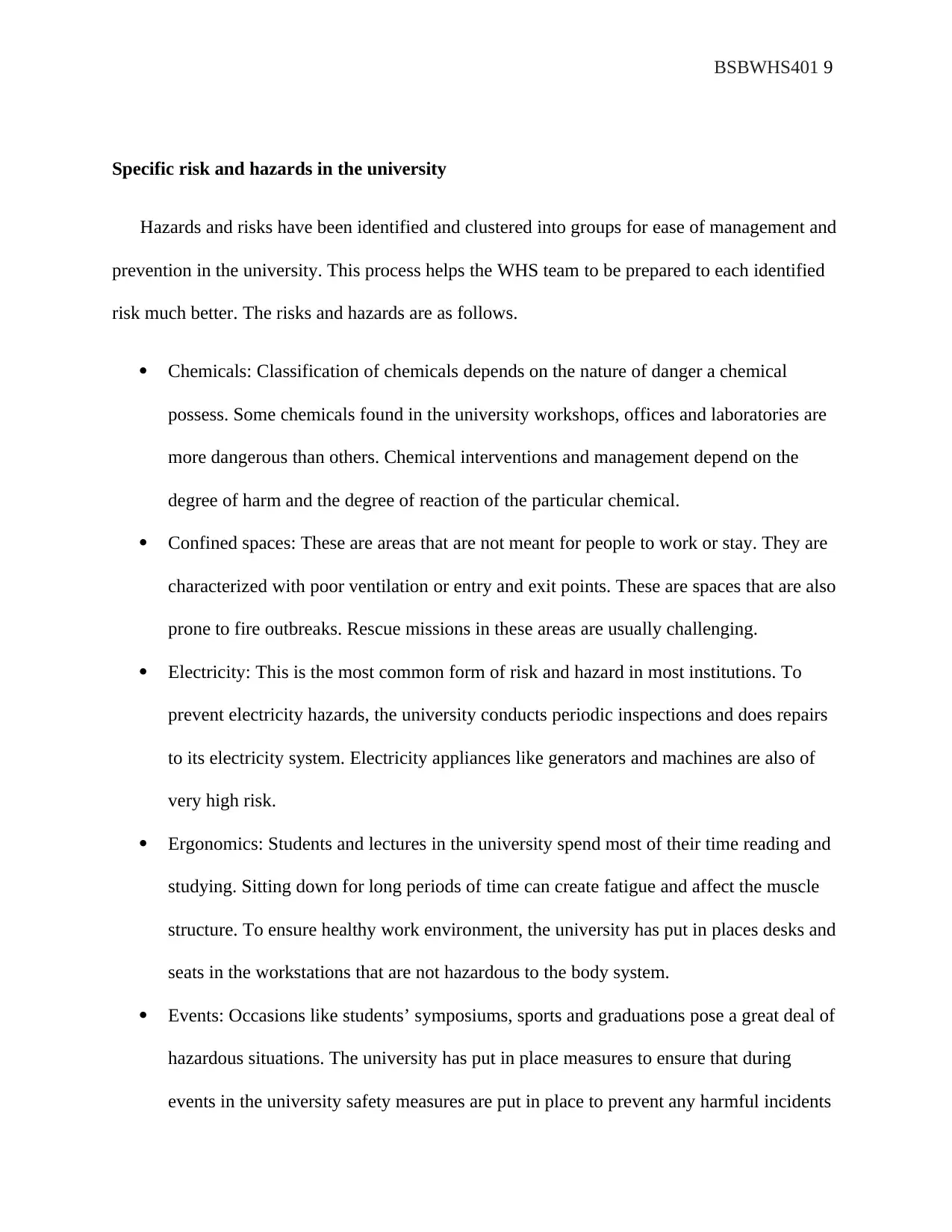
BSBWHS401 9
Specific risk and hazards in the university
Hazards and risks have been identified and clustered into groups for ease of management and
prevention in the university. This process helps the WHS team to be prepared to each identified
risk much better. The risks and hazards are as follows.
Chemicals: Classification of chemicals depends on the nature of danger a chemical
possess. Some chemicals found in the university workshops, offices and laboratories are
more dangerous than others. Chemical interventions and management depend on the
degree of harm and the degree of reaction of the particular chemical.
Confined spaces: These are areas that are not meant for people to work or stay. They are
characterized with poor ventilation or entry and exit points. These are spaces that are also
prone to fire outbreaks. Rescue missions in these areas are usually challenging.
Electricity: This is the most common form of risk and hazard in most institutions. To
prevent electricity hazards, the university conducts periodic inspections and does repairs
to its electricity system. Electricity appliances like generators and machines are also of
very high risk.
Ergonomics: Students and lectures in the university spend most of their time reading and
studying. Sitting down for long periods of time can create fatigue and affect the muscle
structure. To ensure healthy work environment, the university has put in places desks and
seats in the workstations that are not hazardous to the body system.
Events: Occasions like students’ symposiums, sports and graduations pose a great deal of
hazardous situations. The university has put in place measures to ensure that during
events in the university safety measures are put in place to prevent any harmful incidents
Specific risk and hazards in the university
Hazards and risks have been identified and clustered into groups for ease of management and
prevention in the university. This process helps the WHS team to be prepared to each identified
risk much better. The risks and hazards are as follows.
Chemicals: Classification of chemicals depends on the nature of danger a chemical
possess. Some chemicals found in the university workshops, offices and laboratories are
more dangerous than others. Chemical interventions and management depend on the
degree of harm and the degree of reaction of the particular chemical.
Confined spaces: These are areas that are not meant for people to work or stay. They are
characterized with poor ventilation or entry and exit points. These are spaces that are also
prone to fire outbreaks. Rescue missions in these areas are usually challenging.
Electricity: This is the most common form of risk and hazard in most institutions. To
prevent electricity hazards, the university conducts periodic inspections and does repairs
to its electricity system. Electricity appliances like generators and machines are also of
very high risk.
Ergonomics: Students and lectures in the university spend most of their time reading and
studying. Sitting down for long periods of time can create fatigue and affect the muscle
structure. To ensure healthy work environment, the university has put in places desks and
seats in the workstations that are not hazardous to the body system.
Events: Occasions like students’ symposiums, sports and graduations pose a great deal of
hazardous situations. The university has put in place measures to ensure that during
events in the university safety measures are put in place to prevent any harmful incidents
⊘ This is a preview!⊘
Do you want full access?
Subscribe today to unlock all pages.

Trusted by 1+ million students worldwide
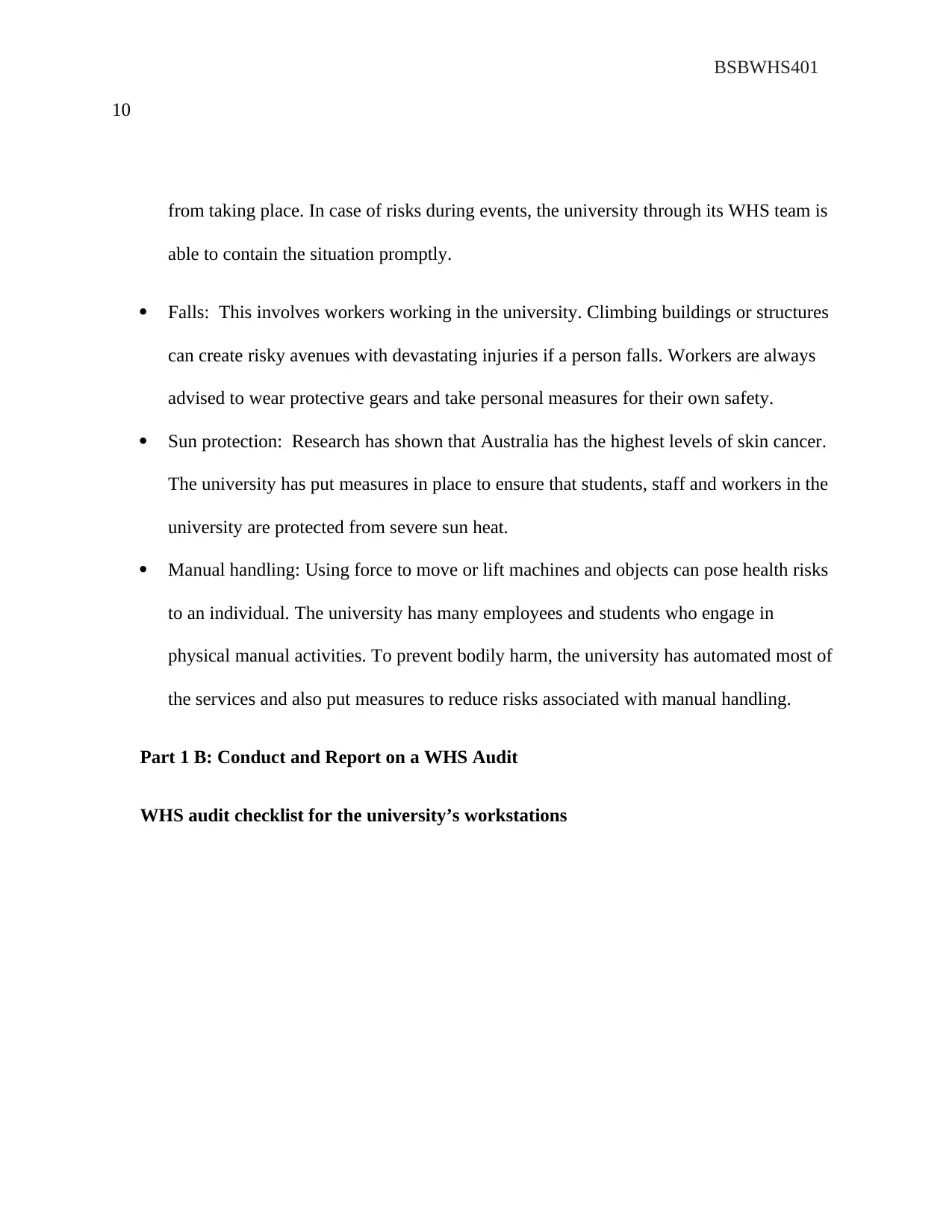
BSBWHS401
10
from taking place. In case of risks during events, the university through its WHS team is
able to contain the situation promptly.
Falls: This involves workers working in the university. Climbing buildings or structures
can create risky avenues with devastating injuries if a person falls. Workers are always
advised to wear protective gears and take personal measures for their own safety.
Sun protection: Research has shown that Australia has the highest levels of skin cancer.
The university has put measures in place to ensure that students, staff and workers in the
university are protected from severe sun heat.
Manual handling: Using force to move or lift machines and objects can pose health risks
to an individual. The university has many employees and students who engage in
physical manual activities. To prevent bodily harm, the university has automated most of
the services and also put measures to reduce risks associated with manual handling.
Part 1 B: Conduct and Report on a WHS Audit
WHS audit checklist for the university’s workstations
10
from taking place. In case of risks during events, the university through its WHS team is
able to contain the situation promptly.
Falls: This involves workers working in the university. Climbing buildings or structures
can create risky avenues with devastating injuries if a person falls. Workers are always
advised to wear protective gears and take personal measures for their own safety.
Sun protection: Research has shown that Australia has the highest levels of skin cancer.
The university has put measures in place to ensure that students, staff and workers in the
university are protected from severe sun heat.
Manual handling: Using force to move or lift machines and objects can pose health risks
to an individual. The university has many employees and students who engage in
physical manual activities. To prevent bodily harm, the university has automated most of
the services and also put measures to reduce risks associated with manual handling.
Part 1 B: Conduct and Report on a WHS Audit
WHS audit checklist for the university’s workstations
Paraphrase This Document
Need a fresh take? Get an instant paraphrase of this document with our AI Paraphraser
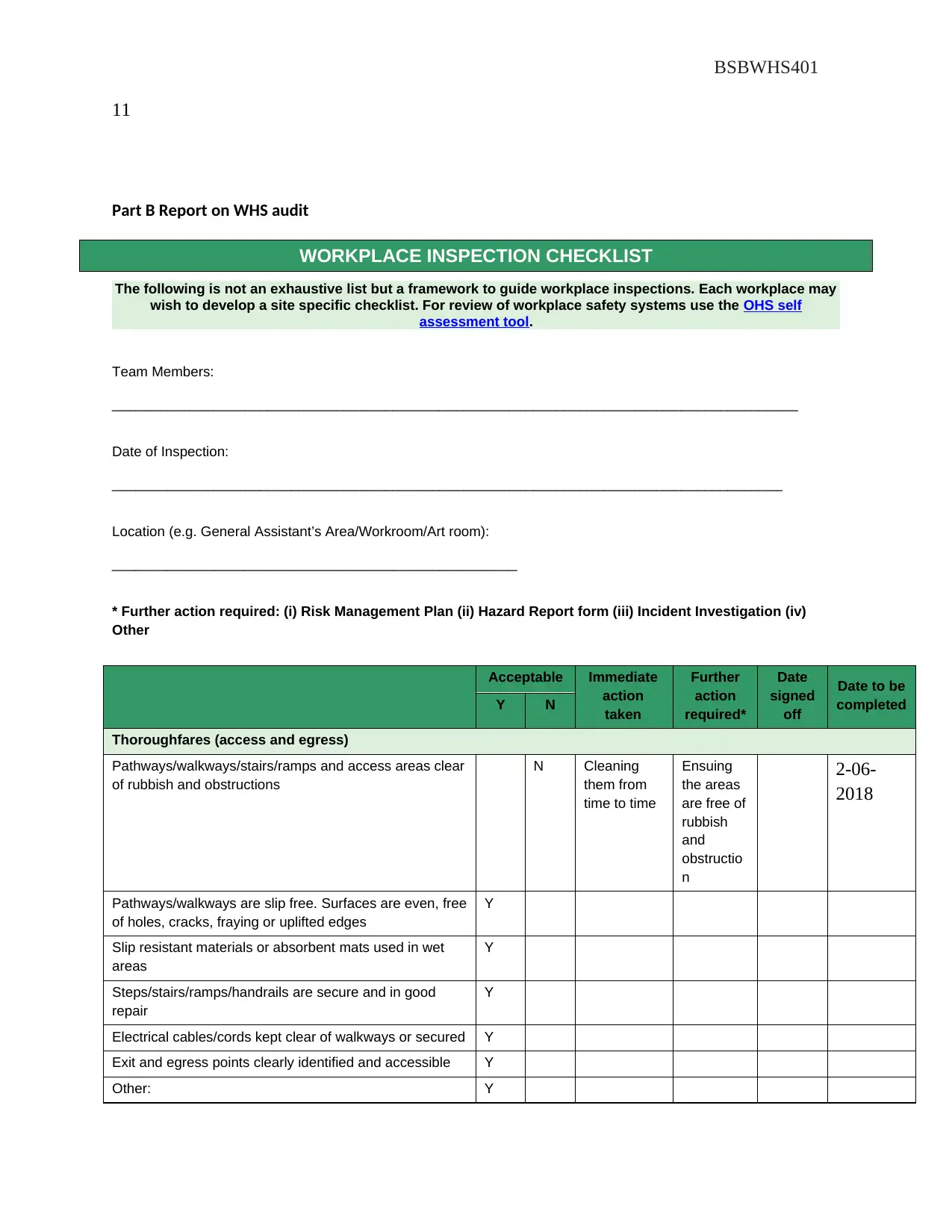
BSBWHS401
11
Part B Report on WHS audit
WORKPLACE INSPECTION CHECKLIST
The following is not an exhaustive list but a framework to guide workplace inspections. Each workplace may
wish to develop a site specific checklist. For review of workplace safety systems use the OHS self
assessment tool.
Team Members:
________________________________________________________________________________________
Date of Inspection:
______________________________________________________________________________________
Location (e.g. General Assistant’s Area/Workroom/Art room):
____________________________________________________
* Further action required: (i) Risk Management Plan (ii) Hazard Report form (iii) Incident Investigation (iv)
Other
Acceptable Immediate
action
taken
Further
action
required*
Date
signed
off
Date to be
completedY N
Thoroughfares (access and egress)
Pathways/walkways/stairs/ramps and access areas clear
of rubbish and obstructions
N Cleaning
them from
time to time
Ensuing
the areas
are free of
rubbish
and
obstructio
n
2-06-
2018
Pathways/walkways are slip free. Surfaces are even, free
of holes, cracks, fraying or uplifted edges
Y
Slip resistant materials or absorbent mats used in wet
areas
Y
Steps/stairs/ramps/handrails are secure and in good
repair
Y
Electrical cables/cords kept clear of walkways or secured Y
Exit and egress points clearly identified and accessible Y
Other: Y
11
Part B Report on WHS audit
WORKPLACE INSPECTION CHECKLIST
The following is not an exhaustive list but a framework to guide workplace inspections. Each workplace may
wish to develop a site specific checklist. For review of workplace safety systems use the OHS self
assessment tool.
Team Members:
________________________________________________________________________________________
Date of Inspection:
______________________________________________________________________________________
Location (e.g. General Assistant’s Area/Workroom/Art room):
____________________________________________________
* Further action required: (i) Risk Management Plan (ii) Hazard Report form (iii) Incident Investigation (iv)
Other
Acceptable Immediate
action
taken
Further
action
required*
Date
signed
off
Date to be
completedY N
Thoroughfares (access and egress)
Pathways/walkways/stairs/ramps and access areas clear
of rubbish and obstructions
N Cleaning
them from
time to time
Ensuing
the areas
are free of
rubbish
and
obstructio
n
2-06-
2018
Pathways/walkways are slip free. Surfaces are even, free
of holes, cracks, fraying or uplifted edges
Y
Slip resistant materials or absorbent mats used in wet
areas
Y
Steps/stairs/ramps/handrails are secure and in good
repair
Y
Electrical cables/cords kept clear of walkways or secured Y
Exit and egress points clearly identified and accessible Y
Other: Y
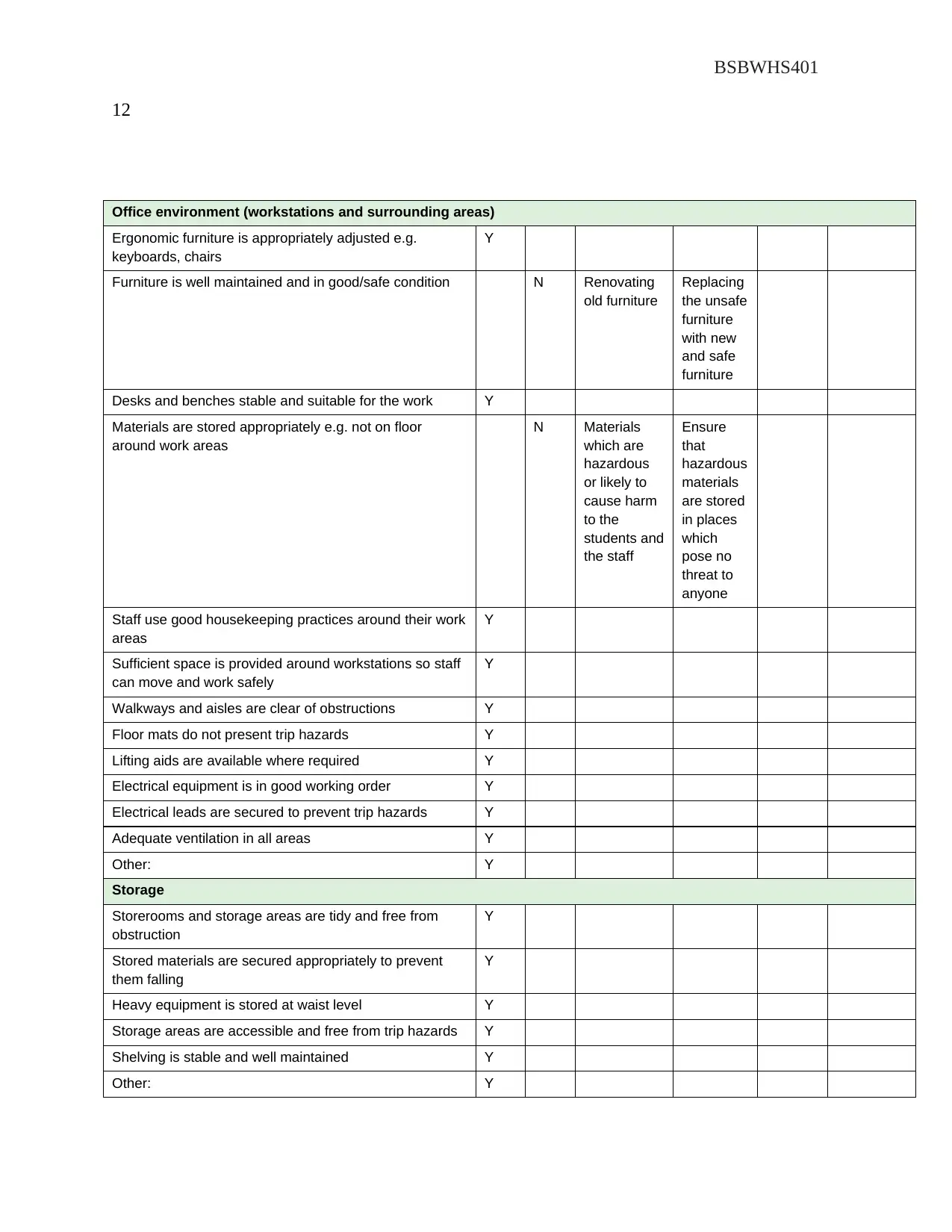
BSBWHS401
12
Office environment (workstations and surrounding areas)
Ergonomic furniture is appropriately adjusted e.g.
keyboards, chairs
Y
Furniture is well maintained and in good/safe condition N Renovating
old furniture
Replacing
the unsafe
furniture
with new
and safe
furniture
Desks and benches stable and suitable for the work Y
Materials are stored appropriately e.g. not on floor
around work areas
N Materials
which are
hazardous
or likely to
cause harm
to the
students and
the staff
Ensure
that
hazardous
materials
are stored
in places
which
pose no
threat to
anyone
Staff use good housekeeping practices around their work
areas
Y
Sufficient space is provided around workstations so staff
can move and work safely
Y
Walkways and aisles are clear of obstructions Y
Floor mats do not present trip hazards Y
Lifting aids are available where required Y
Electrical equipment is in good working order Y
Electrical leads are secured to prevent trip hazards Y
Adequate ventilation in all areas Y
Other: Y
Storage
Storerooms and storage areas are tidy and free from
obstruction
Y
Stored materials are secured appropriately to prevent
them falling
Y
Heavy equipment is stored at waist level Y
Storage areas are accessible and free from trip hazards Y
Shelving is stable and well maintained Y
Other: Y
12
Office environment (workstations and surrounding areas)
Ergonomic furniture is appropriately adjusted e.g.
keyboards, chairs
Y
Furniture is well maintained and in good/safe condition N Renovating
old furniture
Replacing
the unsafe
furniture
with new
and safe
furniture
Desks and benches stable and suitable for the work Y
Materials are stored appropriately e.g. not on floor
around work areas
N Materials
which are
hazardous
or likely to
cause harm
to the
students and
the staff
Ensure
that
hazardous
materials
are stored
in places
which
pose no
threat to
anyone
Staff use good housekeeping practices around their work
areas
Y
Sufficient space is provided around workstations so staff
can move and work safely
Y
Walkways and aisles are clear of obstructions Y
Floor mats do not present trip hazards Y
Lifting aids are available where required Y
Electrical equipment is in good working order Y
Electrical leads are secured to prevent trip hazards Y
Adequate ventilation in all areas Y
Other: Y
Storage
Storerooms and storage areas are tidy and free from
obstruction
Y
Stored materials are secured appropriately to prevent
them falling
Y
Heavy equipment is stored at waist level Y
Storage areas are accessible and free from trip hazards Y
Shelving is stable and well maintained Y
Other: Y
⊘ This is a preview!⊘
Do you want full access?
Subscribe today to unlock all pages.

Trusted by 1+ million students worldwide
1 out of 37
Related Documents
Your All-in-One AI-Powered Toolkit for Academic Success.
+13062052269
info@desklib.com
Available 24*7 on WhatsApp / Email
![[object Object]](/_next/static/media/star-bottom.7253800d.svg)
Unlock your academic potential
Copyright © 2020–2025 A2Z Services. All Rights Reserved. Developed and managed by ZUCOL.





